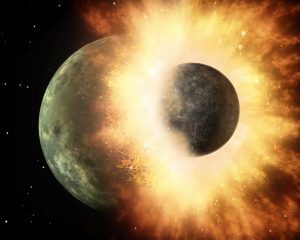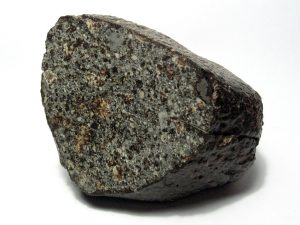15 June 2016
New study questions source of rare Earth metals that provide clues to life’s origins
Posted by Lauren Lipuma
by Lauren Lipuma

Artist’s depiction of a collision between two planetary bodies. Such an impact between Earth and a Mars-sized object called Theia likely formed the Moon. New research revives the debate about whether this impact is be the source of rare Earth metals.
Credit: NASA/JPL-Caltech.
A new study is reviving a decades-old debate about how Earth’s rarest elements came to exist on our planet – theories that have implications for the origin of life.
Most scientists agree the precious metals – gold and the six platinum group elements – were added to Earth’s surface sometime after it formed 4.5 billion years ago. In the late 1980s, scientists debated how this happened. Some thought these elements were added to the Earth’s mantle and crust by countless asteroid impacts during the Late Heavy Bombardment 4 billion years ago, while others believed they came from the collision of Earth and Theia, a planetary body the size of Mars, which spawned our moon 20 million to 100 million years after the solar system’s formation.
After several years of debate, in the early 1990s most researchers decided the evidence pointed toward the Late Heavy Bombardment theory, and the Theia theory fell out of favor.
Now, a new study argues the collision of Earth and Theia could still be the source of the precious metals, reviving the abandoned theory. Norman Sleep, a geophysicist at Stanford University, performed new calculations to show Theia’s core contained enough material to account for the platinum group elements in Earth’s mantle and showed how oxygen in the planet’s mantle could have helped to keep them there.
Figuring out these elements’ source and when the impacts took place could help scientists pinpoint when and how life originated on Earth, Sleep said. Whether there was one giant impact or several smaller ones could tell scientists when Earth was first habitable and whether asteroid impacts drove life to the point of extinction, he said.
“The paper is not intended to be last word on the subject, but rather show that both alternatives still appear to be viable, and that more geochemical work needs to be done,” said Sleep, author of the new paper published today in Geochemistry, Geophysics, Geosystems, a journal of the American Geophysical Union.
The new study could renew the debate about which theory is correct, said Rebecca Fischer, a geophysicist at the Smithsonian National Museum of Natural History who was not involved in the study.
“[He does] some, for the most part, relatively simple calculations to show that it’s a plausible theory,” Fischer said. “I’m not sure if I’m 100 percent convinced yet, but it’s certainly making me think harder about this.”
Two theories
The precious metals are among the rarest on Earth. These metals dissolve in iron and were sucked into Earth’s molten iron core when the planet formed. However, scientists discovered these elements also exist in Earth’s mantle. The platinum group elements exist in the mantle in roughly the same ratios relative to each other as they do in meteorites. This observation led researchers to believe meteors or other foreign objects brought the precious metals to Earth’s surface after the planet formed.

In the late 1980s, scientists posited that Earth’s precious metals were deposited to its surface by asteroid impacts during the Late Heavy Bombardment. These metals are found in Earth’s mantle in roughly the same ratios relative to each other as they do in meteorites, like the one pictured here.
Credit: H. Raab, own work, CC by 3.0, via Wikimedia Commons.
Two theories emerged in the late 1980s to explain how Earth acquired the precious metals and the rocky debris in which they are found, called the “late veneer.” The Late Heavy Bombardment theory argued the veneer came from asteroid impacts occurring over a few hundred million years. Earth’s mantle has more precious metals than the moon’s, leading proponents of the Late Heavy Bombardment theory to deduce that during this time a small number of large asteroids hit Earth but missed the moon, rather than a large number of smaller asteroids that hit both Earth and the moon.
The Theia theory argued the late veneer material came from Theia’s iron core, which sucked in its own share of platinum group elements during its formation. The impact of Theia and Earth would have allowed Theia’s core to mix with Earth’s mantle, but the material would not have made it all the way to the Earth’s core.
In the new study, Sleep analyzed estimates of Theia’s size and iron content to see if these parameters could account for the iron concentrations in the present Earth and moon. He also determined how likely it was that large asteroids could hit Earth while missing the moon during the Late Heavy Bombardment and determined how large such impacts would have to be in order to account for the amounts of precious metals Earth’s mantle has today.
The study shows the amount of iron in Theia’s core could sufficiently account for the platinum group elements in Earth’s mantle and for the iron in the moon’s core. Sleep also shows there was excess oxygen in Earth’s mantle at the time of Theia’s impact. This oxygen combined with iron from Theia’s core when it collided with Earth. While chemically bound to oxygen, the iron could not dissolve the platinum group elements and pull them into the new Earth’s core, and so they remained in the mantle.
According to Sleep, his calculations support both theories, but he tends to lean toward believing the core of Theia theory.
The origin of life
The origin of Earth’s veneer material has implications for when life first evolved on Earth, according to Sleep and Fischer.
“If the Earth got its late veneer from several large impactors during the Late Heavy Bombardment, if life had already evolved at that point, these impacts could have killed it off,” Fischer said. Or, alternatively, the impacts could have killed most existing life but left only those organisms adapted to extreme heat environments, such as bacteria that live in hydrothermal vents, she said.
If asteroid impacts rendered Earth uninhabitable for a long while, it could be more plausible that life first originated on Mars, Sleep said. During the Late Heavy Bombardment, asteroids could have knocked rocks off of Mars and brought them to Earth, he said.
But if the late veneer came from the moon-forming Theia impact, large asteroid impacts during the Late Heavy Bombardment may have been smaller and less destructive than assumed, according to Sleep. If the moon-forming impact was the only impact large enough to sterilize the planet, Earth could have been habitable much sooner and for longer than previously thought, he said.
—Lauren Lipuma is a public information specialist and writer at AGU. You can follow her on twitter at @lipumal.










 GeoSpace is a blog on Earth and space science, managed by AGU’s Public Information staff. The blog features posts by AGU writers and guest contributors on all sorts of relevant science topics, but with a focus on new research and geo and space sciences-related stories that are currently in the news.
GeoSpace is a blog on Earth and space science, managed by AGU’s Public Information staff. The blog features posts by AGU writers and guest contributors on all sorts of relevant science topics, but with a focus on new research and geo and space sciences-related stories that are currently in the news.